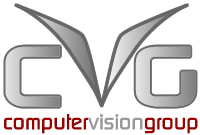Research activities
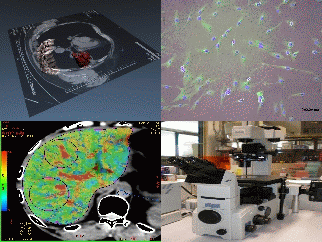 |
2D and 3D medical imaging has become an extremely effective tool for early detection, diagnosis, follow up and
assisted therapy in several diseases, mainly but not only in solid tumours. This has become possible
through the improvement of technologies, instrument resolutions and image analysis techniques.
Effective results in this field, yet more than in other ones, come from multi-disciplinary researches.
Our group is active to cooperate with researchers in medicine, biology and nuclear physics, to develop
new instruments and technologies, providing our specific expertise in image analysis, reconstruction and measurements.
On the other side, image analysis constitutes the enabling technology in several fields, ranging from automatic
cell analysis to cosmetics, even when the detecting device is based on a non-optical sensor. Besides, part of our
research activity is also spent in application-oriented projects in collaboration with researchers in medicine and
biology.
MEDICAL IMAGING AND PHENOTYPING
- RADIOMICS (mpMRI, PET, PET/MRI, CT/PET)
- PERFECT (CT perfusion)
- Digital mammography (RX)
- 3D Positron Emission Tomography (3D PET)
- Combined tomographic and emission methods (CT, SPECT)
MICROSCOPY IMAGING AND PHENOTYPING
- PHENOMICS
- DYNAMO
- STAMINAL
CAPACITIVE IMAGING for skin analysis
- DERMOCAL
- Characterization of the skin cells and wrinkles
3D LASER-SCAN IMAGING for bone analysis
- CUSTOM IMPLANTS
SOME DEMOS
|
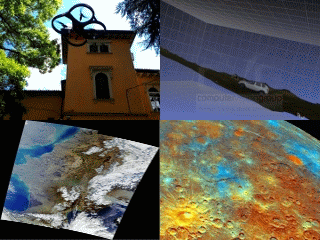 |
Aerial and satellite imaging represent an increasing research area that is spreading its application domain, from
environmental monitoring, to 3D aerial view reconstruction and panorama, to self-localisation to determine attitude and position
( i.e., the pose) of aerial vehicles or orbiting satellites exploiting image-based information only. However, merging
this information with data coming from the status vector of the aerial vehicle works to strengthen measurement computations and
improve the attitude accuracy, accordingly.
The CVG's quantitative imaging techniques have been developed and successfully applied to reconstruct the
trajectory of an Earth LEO satellite, as well as to help determining the
libration of the Mercury planet. The same technologies allow reconstructing
a 3D aerial view acquired using a commercial low-cost drone.
PROJECTS: 3-DARE, STARS, ASIMO)
|
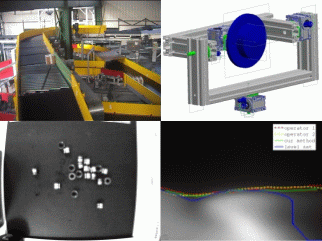
|
Vision-based methods are more and more entering into diverse application fields due to
three main advantages that the technology has brought in. First, vision-based systems
can mimic the simplest human brain functions to perform automatically tasks like target's
counting and classification, or even defect analysis.
Second, a digital image yields photometric as well as geometric information and a video
sequence offers information regarding the evolution of parameters of the objects being
studied. This means that one cheap CCD sensor could replace an ensemble of traditional sensors,
thus making a system far simpler and, possibly, cheaper. Finally, vision-based systems
of course provide a visual feedback on what is being measured and, in general, on what happens.
This makes these systems the best likely candidate to help, or even replace, human
beings to automatize measuring tasks and to achieve reproducible and repeatable measurements.
- Outlines of image-based measurements and
3D stereoscopy
- Measurements of vehicle trajectory using 3D stereoscopy
- Measurements of geometric properties of a vehicle beam's light profile
- Measurements of angular relative motion between camera and shot object
Some BIBLIOGRAPHY
- MAVERIK
AUTOMOTIVE
- AUTOBEAM
- EASEBIKE
|
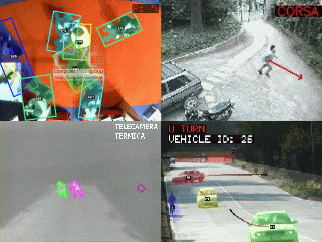
|
Most of the information useful for scene understanding stem from motion detection.
However, changes in scenes may also be originated by either acquisition sensor noise
or more simply by changes in the environmental illumination. The first step of motion
analysis addresses automatic methods to discriminate between uninteresting scene
changes and real motion. Nevertheless, moving objects (people included) are often detected
together with their cast shadow, which must be removed before analysing each object
and extracting its properties.
After that, the objects detected as being moving are followed
in time, by automatically identifying and tracking their features that keep invariant.
For instance, this permits to count and classify the moving objects.
Finally, their trajectory is built in real time and analysed so as to discover events or infer
interesting behaviours.
Applications of our algorithms have been found in video surveillance, detection of events in
traffic monitoring and behaviour analysis of people walking in museums, fairs, etc.
- Motion detection
- Removal of moving shadows
- People/Object tracking and event detection
PROJECTS ( ENVISAGED)
INDUSTRIAL APPLICATIONS
Some BIBLIOGRAPHY and DEMOS
|
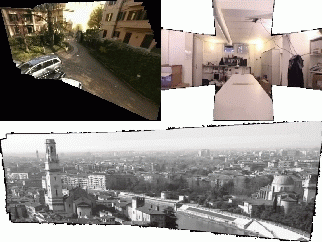
|
|

|
|
|
